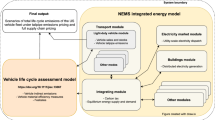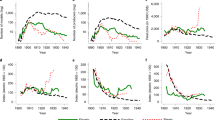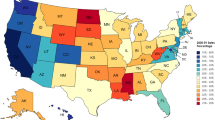Abstract
The purchase of multifuel vehicles (MFVs) has been incentivized by policies across the globe. Such vehicles are able to operate on more than one source of energy, so they introduce fuel (or energy) choice as one additional dimension consumers decide about. As fuels differ in terms of carbon emissions, this choice has environmental effects. Using 12 years of monthly Swedish data, here I show that the majority of MFV drivers purchase petrol when it is priced at parity with ethanol. Through policy simulations, I document that fossil fuel taxes have limited success in making drivers switch to alternative fuels and can generate economic distortions. The findings question the cost-effectiveness of programmes to incentivize the purchase of MFVs that ignore the fuel choice dimension and highlight the importance of accounting for fuel choice in the analysis of public policy and emerging technologies.
This is a preview of subscription content, access via your institution
Access options
Access Nature and 54 other Nature Portfolio journals
Get Nature+, our best-value online-access subscription
$29.99 / 30 days
cancel any time
Subscribe to this journal
Receive 12 digital issues and online access to articles
$119.00 per year
only $9.92 per issue
Buy this article
- Purchase on Springer Link
- Instant access to full article PDF
Prices may be subject to local taxes which are calculated during checkout

Similar content being viewed by others
References
Salvo, A. & Huse, C. Build it, but will they come? Evidence from consumer choice between gasoline and sugarcane ethanol. J. Environ. Econ. Manag. 66, 251–279 (2013).
Huse, C. & Lucinda, C. The market impact and the cost of environmental policy: evidence from the Swedish green car rebate. Econ. J. 124, F393–F419 (2014).
Huse, C. Fast and Furious (and Dirty): How Asymmetric Regulation may Hinder Environmental Policy MPRA Paper 48909 (Munich Personal RePEc Archive, 2014); https://mpra.ub.uni-muenchen.de/48909/
Beresteanu, A. & Li, S. Gasoline prices, government support, and the demand for hybrid vehicles. Int. Econ. Rev. 52, 161–182 (2011).
Covert, T., Greenstone, M. & Knittel, C. R. Will we ever stop using fossil fuels? J. Econ. Perspect. 30(6), 117–138 (2016).
Graff-Zivin, J. S., Kotchen, M. J. & Mansur, E. T. Spatial and temporal heterogeneity of marginal emissions: implications for electric cars and other electricity-shifting policies. J. Econ. Behav. Organ. 107, 248–268 (2014).
Robinson, P. M. Root-N-consistent semiparametric regression. Econometrica 56, 931–954 (1988).
Small, K. A. & Van Dender, K. Fuel efficiency and motor vehicle travel: the declining rebound effect. Energy J. 28, 25–52 (2007).
Hughes, J. E., Knittel, C. R. & Sperling, D. Evidence of a shift in the short-run price elasticity of gasoline. Energy J. 29, 113–134 (2008).
Brons, M., Nijkamp, P., Pelsa, E. & Rietveld, P. A meta-analysis of the price elasticity of gasoline demand. A SUR approach. Energy Econ. 30(5), 2105–2122 (2008).
Anderson, S. T. The demand for ethanol as a gasoline substitute. J. Environ. Econ. Manag. 63, 151–168 (2012).
Khachatryan, H., Yan, J. & Casavant, K. Spatial differences in price elasticity of demand for ethanol. J. Transp. Res. Forum 50(3), 43–61 (2011).
Mandell, S. Carbon emission values in cost–benefit analyses. Transp. Policy 6(18), 888–892 (2008).
Holland, S. P., Mansur, E. T., Muller, N. Z. & Yates, A. J. Are there environmental benefits from driving electric vehicles? The importance of local factors. Am. Econ. Rev. 106(12), 3700–3729 (2016).
Corts, K. S. Building out alternative fuel retail infrastructure: government fleet spillovers in E85. J. Environ. Econ. Manag. 59, 219–234 (2010).
Shiver, S. K. Network effects in alternative fuel adoption: empirical analysis of the market for ethanol. Mark. Sci. 34(1), 78–97 (2015).
Pavan, G. Green Car Adoption and the Supply of Alternative Fuels TSE Working Paper 17-875 (Toulouse School of Economics, 2017); https://www.tse-fr.eu/publications/green-car-adoption-and-supply-alternative-fuels
Springel, K. Essays in Industrial Organizationand Environmental Economics Ch. 2 PhD thesis, Univ. California Berkeley (2017); http://digitalassets.lib.berkeley.edu/etd/ucb/text/Springel_berkeley_0028E_17004.pdf
Li, S., Lang, T., Xing, J. & Zhou, Y. The market for electric vehicles: indirect network effects and policy impacts. J. Assoc. Environ. Resour. Econ. 4(1), 89–133 (2017).
del Granado, F. J. A., Coady, D. & Gillingham, R. The unequal benefits of fuel subsidies: a review of evidence for developing countries. World Dev. 40(11), 2234–2248 (2012).
Clements, B., Coady, D., Fabrizio, S., Gupta, S. & Shang, B. Energy Subsidy Reform: Lessons and Implications (International Monetary Fund, Washington, 2013).
Davis, L. W. The economic cost of global fuel subsidies. Am. Econ. Rev. Pap. Proc. 104(5), 581–585 (2014).
Coady, D., Parry, I. W. H., Sears, L. & Shang, B. How Large Are Global Energy Subsidies? (International Monetary Fund, Washington, 2015).
Davis, L. W. The environmental cost of global fuel subsidies. Energy J. https://doi.org/10.5547/01956574.38.SI1.ldav(2017).
Guidelines for Preparing Economic Analyses (US Environmental Protection Agency, Washington DC, 2014).
Honk Kong Gasoline Prices (The Global Economy, accessed 17 April 2018); www.theglobaleconomy.com/Hong-Kong/gasoline_prices/
Gasoline Prices around the World: The Real Cost of Filling Up (Bloomberg, accessed 17 April 2018); www.bloomberg.com/graphics/gas-prices/
Statistics (SPBI, accessed 17 April 2018); http://spbi.se/statistik/
Current Fuel Prices (Circle K, accessed 17 April 2018); www.circlek.se/sv_SE/pg1334072467111/privat.
IMF Primary Commodity Prices (IMF, accessed 17 April 2018); www.imf.org/external/np/res/commod/index.aspx
Acknowledgements
I am indebted to N. Koptyug and C. Lucinda for their comments on an earlier draft of the paper.
Author information
Authors and Affiliations
Contributions
C.H. performed the data analysis, simulations and wrote the manuscript.
Corresponding author
Ethics declarations
Competing interests
The author declares no competing interests.
Additional information
Publisher’s note: Springer Nature remains neutral with regard to jurisdictional claims in published maps and institutional affiliations.
Supplementary information
Supplementary Information
Supplementary Tables 1–8, Supplementary Notes 1–2, Supplementary Discussion, Supplementary Methods, Supplementary References
Rights and permissions
About this article
Cite this article
Huse, C. Fuel choice and fuel demand elasticities in markets with flex-fuel vehicles. Nat Energy 3, 582–588 (2018). https://doi.org/10.1038/s41560-018-0175-3
Received:
Accepted:
Published:
Issue Date:
DOI: https://doi.org/10.1038/s41560-018-0175-3
This article is cited by
-
Fuelling behaviour change
Nature Energy (2018)



